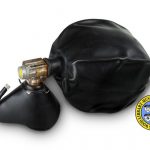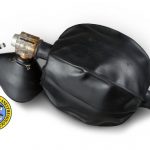Ambu Bag
The Danish anesthesiologist, Dr. Henning Ruben (1914-2004) was a talented athlete, entertainer, and inventor. He brought his wide-ranging abilities to a specialty that also calls for a combination of skills. In 1954, a shortage of oxygen deliveries to Danish hospitals prompted him to invent the first self-inflating resuscitator, the Air Mask Bag Unit (AMBU). Originally built on a frame of bicycle spokes, the bag springs back into shape after each compression, automatically refilling itself with fresh air. An inflating (non-rebreathing) valve allows the operator to keep the mask firmly in place over the patient’s nose and mouth while preventing the patient from rebreathing his exhaled carbon dioxide. The following year, Dr. Ruben introduced a slightly modified non-rebreathing valve for pediatric anesthesia patients.
The Danish manufacturer, Testa Laboratory, made the first commercially-produced Ambu bags in 1957. The company changed its name, and is now called Ambu International. Many other companies now also make self-inflating “bag and mask” resuscitators, like the one shown here. These have become standard equipment in ambulances, hospital emergency rooms, and patient rooms.
Catalog Record: Ambu Bag
Access Key: akvz
Accession No.: 2013-09-06-2
Title: [Ambu valve and bag.]
Author: Ruben, Henning M. (Moritz), 1914-2004.
Author: Hesse, Holger.
Title variation: Alt Title
Title: Ambu resuscitator.
Title variation: Alt Title
Title: Ambu bag.
Title variation: Alt Title
Title: Ambu valve and self inflating bag.
Title variation: Alt Title
Title: Ambu mask-valve-bag.
Publisher: [Hatboro, Pennsylvania] : [Air-Shields, Inc.], [1959-1990]
Physical Descript: 1 resuscitation apparatus : rubber, metals, plastics ; 32 x 16 x 14.5 cm.
Subject: Resuscitation – instrumentation.
Subject: Respiration, Artificial – instrumentation.
Note Type: General
Notes: The early year in the date range for the possible year of manufacture for
this Ambu bag and valve is based on the date of the earliest publication in
which AMBU by Air-Shields was found (1959 Anesth Analg). The end year is an
estimate based on the time when reusable black rubber resuscitation bags were
being replaced with disposable equipment as reflected in journal articles and
books.. The date range could change if documentation indicates the range
should be corrected.
Note Type: General
Notes: Title and manufacturer information is based on the manufacturer markings on
the valve attached to the bag, and on the common name for the object.
Note Type: With
Notes: For the purposes of functional representation on the WLM website the valve
and bag were photographed with a black rubber oronasal mask from a
resuscitation kit of another acquisition (2007-01-03-2 A); When measured with
the mask from a patient’s perspective the mask-valve-kit measures
approximately 38 x 16 x 18 cm; The mask is marked “LARGE ADULT [new line] PAT
NO. 2,875,757 [new line] OHIO CHEMICAL UL [new line] CONDUCTIVE; Facing the
mask from a patient’s perspective, it measures approximately 13 x 9 x 9 cm.
Note Type: With
Notes: Ambu history. Ambu website. https://www.ambu.
com/corp/about_ambu/our_company/history.aspx. Accessed August 24, 2014.
Note Type: Citation
Notes: Baskett P, Zorab J. Henning Ruben: The Ruben Valve and the AMBU Bag.
Resuscitation. 2003;56(2):123-127.
Note Type: Citation
Notes: Fahey DG. The self-inflating resuscitator — evolution of an idea. Anaesth
Intensive Care. 2010;38(suppl 1):10-15.
Note Type: Citation
Notes: Ruben H. Anesthesia and resuscitation equipment I happened to be involved
with. In: Rupreht J, van Lieburg MJ, Lee JA, Keys TE, eds. Anaesthesia:
Essays on Its History. Berlin: Springer-Verlag;1985:65-68.
Note Type: Citation
Notes: Ruben H, inventor. Apparatus for artificial respiration. US patent 3,009,459.
November 21, 1961. https://www.google.com/patents/US3009459. Accessed August
24, 2014.
Note Type: Citation
Notes: Ruben H. Short communication: self-contained resuscitation equipment. Can Med
Assoc J. January 1, 1959;80(1):44-45. https://www.ncbi.nlm.nih.
gov/pmc/articles/PMC1830329/. Accessed August 24, 2014.
Note Type: Citation
Notes: Wherever seconds count Ambu rescue breathing equipment – is read to save life
[marketing brochure]. Hatboro, Pa.: Air-Shields, Inc.; 1959.
Note Type: Citation
Notes: When second count … AMBU to restore the breath of life [advertisement].
Anesth Analg. September-October, 1959;38(5):44.
Note Type: Citation
Notes: Zorab J. Henning Ruben. BMJ. 2005;330(7482):94. https://www.ncbi.nlm.nih.
gov/pmc/articles/PMC543884/. Accessed August 24, 2014.
Note Type: Physical Description
Notes: One non-rebreathing valve attached to one black rubber self inflating
resuscitation bag; The bag and valve are in good condition; The bag
foam-lined; From the end of the non-rebreathing valve to the end of the
air-inlet valve the two measure approximately 31.8 cm; Treating the side on
which the non-rebreathing valve opens as the front, the bag measures
approximately 16 cm in width and 14.3 cm in depth; A nipple for connecting
oxygen tubing extends from the center of the air-inlet valve; Part of the
valve is made of clear plastic so that the inner movements of the valve may
be viewed; There are no markings on the bag or air-inlet valve; The
non-rebreathing valve is marked, “AMBU valve [new line] U.S. PATENT – 3,009,
459 [new line] AIR-SHIELDS, INC [new line] Hatboro, Pennsylvania, U.S.A.”
Note Type: Reproduction
Notes: Photographed by Mr. Steve Donisch, September 16, 2013, with the mask from
accession number 2007-01-03-2.
Note Type: Citation
Notes: In 1954, oxygen tank deliveries to Danish hospitals were interrupted due to a
strike by truck drivers who transported gasoline to filling stations. At that
time, the most common equipment used in hospitals to help patients breathe
required oxygen from tanks, or motorized pumps.
Anesthesiologist, Dr. Henning Ruben (1914-2004), was concerned about the
oxygen shortage, and unsatisfied with the bellows that were sometimes used to
artificially ventilate patients. He began to design a device that could be
used to artificially ventilate patients using room air only. His aim was to
create a manual ventilation device that required little work of the operator
and provided good tactile feedback. Around 1955, Dr. Henning created a
working model of a self-inflating breathing bag. It could be used with one
hand, and it did not require other equipment to fill it with oxygen and air
because, after it was squeezed, it re-expanded on its own.
Ruben took the prototype to Holger Hess, with whom he had worked before to
create a suction device and a non-rebreathing valve. In 1956, after some
modifications, Hess’s company, Testa Laboratory, began to manufacture the
self-inflating bag. They named it the “Ambu Bag.” It was so rapidly
integrated into a number of medical care settings world-wide that the phrase
‘Ambu Bag’ became synonymous with self-inflating breathing bags. In 1986,
Testa Laboratory changed its name to Ambu International.
Many medical historians have declared the Ambu bag to be one of the most
important inventions in the history of anesthesiology, emergency care and
resuscitation. Because of how important these bags are to resuscitation they
are also commonly called ‘resuscitation’ bags.
Note Type: Publication
Notes: Barnes TA, McGarry WP III. Evaluation of ten disposable manual resuscitators.
Respir Care. 1990;35(10):960-968.
Note Type: Publication
Notes: Barnes TA, Potash R. Evaluation of five adult disposable operator-powered
resuscitators. Respir Care. 1989;34(4):254-2561.
Note Type: Publication
Notes: Kissoon N, Nykanen D, Tiffin N, Frewen T, Brasher P. Evaluation of
performance characteristics of disposable bag-valve resuscitators. Crit Care
Med. 1991;19(1):102-107.
Note Type: Publication
Notes: Køhnke OB, inventor; Ambu International A/S, assignee. Disposable
resuscitator. US patent 5,163,424. November 17, 1992. https://docs.google.
com/viewer?url=patentimages.storage.googleapis.com/pdfs/US5163424.pdf.
Accessed August 24, 2014.
Note Type: Exhibition
Notes: Selected for the WLM website.



